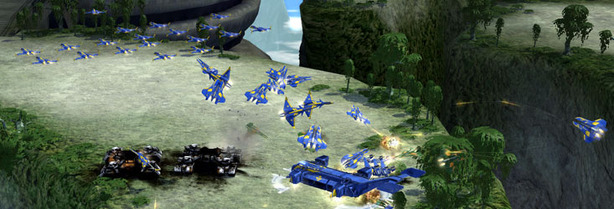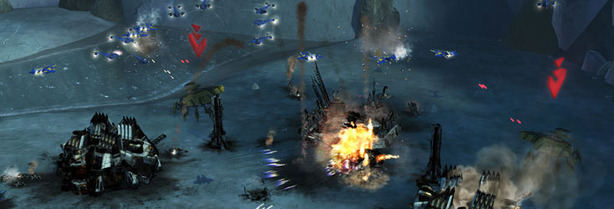
Resources and Experimentals
Those worrying that the game has received a total overhaul can be reassured though, as much of the framework and resource system of the original has survived intact.Different types of units are still produced from three distinct factories (land, sea and air) and the linking style of base building, where structures gain benefits from those built around them is still in effect. Similarly, you still need to collect both mass (from specific mass extraction points) and generate power (from power stations) in order to build units.
However, the managing of the in-game economy has been heavily simplified and while in the original SupCom the resource system was handled as a continuous supply, often having you manage your resources based on a predicted deficient and sometimes having to stop construction of a high end unit in order to churn out more troops, SupCom2 immediately debits your resources for any units ordered; if you want to queue up building 50 gunships, you’ll need to pay for them all now. This is a military campaign after all, not a DFS sofa-sale. No credit. No pay later.
To hell with camouflage!
There’s now a third resource too in the form of research points, collected by fighting the enemy or occasional battlefield power-ups and used to advance up the tech tree in place of the original game’s tiered upgrades. The new system is a lot more intuitive than having to individually upgrade factories or structures and also allows for a more varied degree of army customisation dependant on your style of play as you’re now able to buff the ACU or land, sea and air units independently. This also means that unlocking more advanced units can be done quickly, letting you roll out the big guns and experimental units faster at the cost of a more well rounded force.
There are some minors niggles though as you’re now unable to set a factory to produce units continuously due to the revised resource system – a sad loss considering what a useful feature this was in the original. Similarly you’re unable to give build orders to multiple construction units simultaneously, having to frustratingly select a single construction unit, assign it a job, and then add other construction units to assist. Little problems sure, but they only detract from the Supreme Commandery-ness of SupCom2 - hopefully these can be addressed.
Explosions. These happen a lot.
Perhaps the biggest change to SupCom2’s gameplay though is the rebalancing of “experimental” units. In the original these were titanic monsters, able to take on an enemy army by themselves and requiring enormous resource investment over a long period of time. Of course, the pay off of watching your super artillery pound the enemy base on the other side of the map or your submarine aircraft carrier factory surface and unleash hell was well worth it, so it’s a shame that SupCom2’s bigger units now seem to be a lot less epic. Experimental gunships are churned out from their own factory and even a mighty experimental aircraft carrier is thrown together in a few minutes. Of course, the demo only gives us a first glimpse of what’s to come, but it seems as though these extra special units have been made more than a little less special.
While we’ve seen plenty we’re not too enamoured with in the SupCom2 demo, it’s important to remember that a lot of what made SupCom so great isn’t in evidence here in the demo. While we understand the inclusion of the singleplayer campaigns, it was skirmish and multiplayer that kept you coming back to the game in the long run and while there’s reportedly now a 500 unit cap per player in multiplayer, that’s still plenty for some suitably bonkers massive techno-rumbles once you throw a few mates into the mix. We'll take a more in-depth look when the full game hits next week.
Had a chance to try the demo yourself? Still play the original SupCom? Want to tell us how great giant laser wielding mecha-spiders are? Let us know in the forums.

MSI MPG Velox 100R Chassis Review
October 14 2021 | 15:04











Want to comment? Please log in.